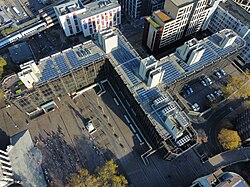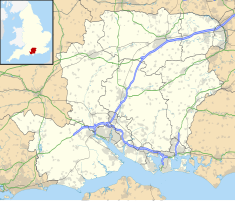Portsmouth Civic Offices
| Portsmouth Civic Offices | |
|---|---|
 The building in 2022 | |
| Location | Guildhall Square, Portsmouth |
| Coordinates | 50°47′50″N 1°05′29″W / 50.7973°N 1.0913°W |
| Built | 1976 |
| Architect | Harry Teggin and David Taylor |
| Architectural style(s) | International style |
Portsmouth Civic Offices is a municipal building in Portsmouth, a city in Hampshire, in England. It is the administrative headquarters of Portsmouth City Council.
History
[edit]During the Second World War, the area to the east of the Guildhall, including Russell Street and Sussex Street, was badly damaged by German bombing.[1][2][3] After the war, several proposals to redevelop the area were considered but rejected by the council. In 1963, after a masterplan for the area was devised by Lionel Brett, the council decided that the surviving buildings should be demolished to create a 38 acres (15 ha) pedestrian area to be known as the Guildhall Square.[4] It was envisaged that the guildhall would be on the west side of the square, new civic offices on the north and east sides and a new central library to the south. The new civic offices were intended to accommodate the increasing needs of council officers and their departments.[5]
The foundation stone to mark the construction of the civic offices and the guildhall square was laid by the Lord Mayor of Portsmouth, Phyllis Loe, on 19 December 1972.[6] An existing statue of Queen Victoria, which had been sculpted by Alfred Drury in bronze, placed on a granite pedestal and unveiled by Lady Dupree in 1903, was relocated to a new position in front of the proposed civic offices at that time.[7] The new civic offices were designed by Harry Teggin and David Taylor in the International style, built in glass and steel, and were officially opened by Admiral of the Fleet Earl Mountbatten of Burma on 15 November 1976.[8][9] Mountbatten also received the Freedom of the City of Portsmouth during his visit.[10][11]
The design involved a six-storey building facing two sides of the Guildhall Square, with its glass walls designed to reflect the guildhall, and an additional wing stretching out behind. The building was approached by a flight of steps mirroring the steps to the guildhall on the opposite side of the square. Its design, which involved extensive use of black glass led to issues with solar gain and heat loss.[12] The civic offices were used as the administrative headquarters of the council, with the council chamber in the guildhall remaining the venue for council meetings.[13]
In July 2022, the council decided that the building was no longer-fit-for-purpose, because of its extensive use of black glass with no air conditioning to dissipate the heat, and because of the increased use of home-working.[14][15][16] In March 2023, the council resolved to explore options to reduce the size of the complex, or to relocate to alternative premises:[17] the options available were considered by the council in February 2024.[18] In November 2024 Historic England issued a Certificate of Immunity from Listing, guaranteeing that the building would not be statutorily listed within the next five years.[19]
References
[edit]- ^ "This city centre view is just about recognisable today". Portsmouth News. 8 June 2016. Retrieved 28 June 2024.
- ^ "Sussex Street, Portsmouth". Sense of Place South East. Retrieved 28 June 2024.
- ^ "Ordnance Survey Map". 1900. Retrieved 28 June 2024.
- ^ Groombridge, Garth (2017). Portsmouth in 50 Buildings. Amberley Publishing. ISBN 978-1445664071.
- ^ "Portsmouth Guildhall Square". British Film Institute. 1976. Retrieved 28 June 2024.
- ^ "Portsmouth City Centre: Queen Victoria". Memorials in Portsmouth. Retrieved 28 June 2024.
- ^ Historic England. "statue of Queen Victoria (1104315)". National Heritage List for England. Retrieved 28 June 2024.
- ^ "Guildhall and Victoria Park: Conservation Area No 18" (PDF). Portsmouth City Council. p. 4. Retrieved 28 June 2024.
- ^ "Civic Centre, Portsmouth: the Guildhall Square with the elevation of the Guildhall Block on the right and the Brunel Block at the back". Royal Institute of British Architects. Retrieved 28 June 2024.
- ^ Sadden, John (2012). The Portsmouth Book of Days. The History Press. ISBN 978-0752485874.
- ^ "Grant of the freedom of the city of Portsmouth to Lord Mountbatten and the opening of the new civic offices". University of Southampton. 1976. Retrieved 28 June 2024.
- ^ Murray, Peter; Trombley, Stephen (1984). Modern British Architecture Since 1945. F. Muller. p. 108. ISBN 978-0584400069.
- ^ "Extraordinary Full Council meeting" (PDF). Portsmouth City Council. 28 May 2024. Retrieved 28 June 2024.
- ^ "Portsmouth City Council urged to move from civic offices". BBC. 21 July 2022. Retrieved 28 June 2024.
- ^ "Portsmouth City Council 'needs to leave Civic Offices as soon as possible'". The News. 20 July 2022. Retrieved 28 June 2024.
- ^ "Portsmouth's Civic Offices have been running at 'less than a fifth full'". The News. 28 September 2022. Retrieved 29 June 2024.
- ^ "Plans will be drawn up for Portsmouth City Council to move out of 'vastly inefficient' Civic Offices". The News. 9 March 2023. Retrieved 28 June 2024.
- ^ Paine, Toby (29 February 2024). "Portsmouth City Council's civic offices could be downsized or replaced as they are too big". The News. Retrieved 28 June 2024.
- ^ Historic England (28 November 2024). "Portsmouth Civic Offices, Guildhall Square, Portsmouth, PO1 2AL (Certificate of Immunity from Listing) (1490064)". National Heritage List for England. Retrieved 29 November 2024.

